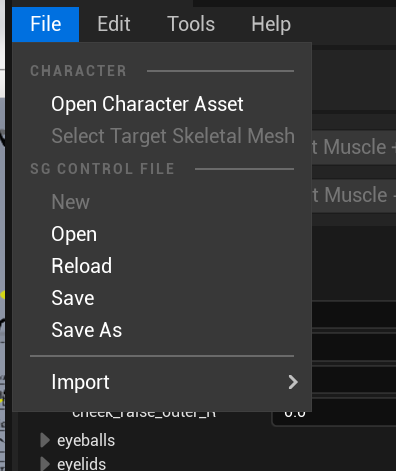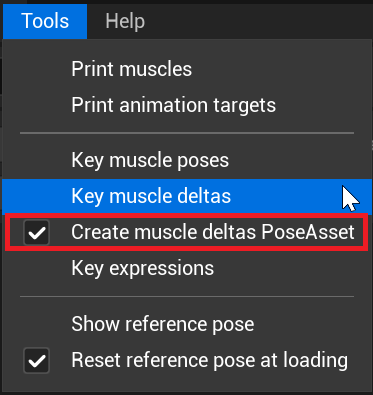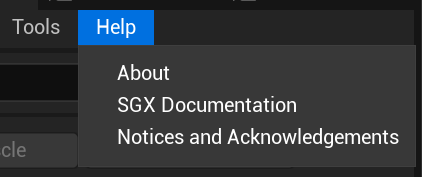Menu Functions (UE)
The menu bar at the top of the plugin window contains tools and actions for working on the Character Control File.
File
The File dropdown menu contains options for opening, saving, or importing character assets.

File > Open Character Asset
Opens a dialogue to select the character assets: the Unreal character asset and the Speech Graphics character control file. (See Character Assets).

If the Asset type is a blueprint, SGX Studio will find the first skeletal mesh in the blueprint and use it as the target mesh. To change the target mesh, click File > Select Target Skeletal Mesh, which presents a list of available meshes in the blueprint to choose from.
File > Open
Opens a dialogue to select a new character control file.
File > Reload
Reloads the current character control file.
File > Save (As)
Any changes made to the character control file (animation targets, reference pose, neutral pose, muscles, closures or behavior modes) require saving the file to be preserved. Use File > Save to save to re-save the current file, and File > Save As to save it as a new file.
File > Import > Modes
The behavior modes of the selected character control file will be merged into the existing set of modes. Any imported behavior mode with the same name as an existing behavior mode will be differentiated by having a numeral appended to its name.
If imported expressions use muscles that are not present in the target character, the imported expressions will lack those muscles.
Imported expressions may need fine-tuning, as they may be uniquely suited to the source character.
Edit
The Edit dropdown menu currently provides options for editing the neutral pose and reference pose of the character.

Edit > Set neutral pose
Sets the neutral pose of the character to the current pose in the scene.
Edit > Reset reference pose
Resets the reference pose of the character to its current pose in the scene.
Tools
The Tools dropdown menu contains a number of actions that are useful when editing and testing a character control file.

Tools > Print muscles
Prints to the log a list of all muscles of the character.
Tools > Print animation targets
Prints to the log a list of all animation targets.
Tools > Key muscle poses
Creates an animation sequence containing all of the character’s muscle poses, to animate the range of motion. Muscle poses are separated from each other by returning to the neutral pose. Spacing of poses is 10 frames. The names of the poses and the frame numbers at which they appear are printed to the log. The resulting animation sequence may be found in the same folder as the character asset.
Note that some muscle poses include other displacements to improve visibility of the muscle movement; for example, the jaw will open to demonstrate lip poses that bring the lips towards each other.
Tools > Key muscle deltas
Creates an animation sequence containing the neutral pose and each of the muscle poses. Frame 0 is the neutral pose, and frame 1 and onward are the muscle poses. The resulting animation sequence may be found in the same folder as the character asset.
In this function, each muscle pose is the pure delta contributed by the muscle, with no adjustments to improve visibility of the movement.
This tool is useful for creating Unreal Animation Pose Assets out of the neutral and muscle poses. Then SGX Events can be imported as weights on those poses, using the Pose Weights animation import mode. This approach gives animators full visibility of the underlying poses involved in the animation.
In order to create a Pose Asset directly, set the option Create muscle deltas PoseAsset to true before invoking Key muscle deltas.

For a video flythrough of how to create a Pose Asset and import animation as pose weights, see Importing Animation.
Tools > Key expressions
Creates an animation sequence containing each of the expressions in the behavior modes keyed at intervals of 10 frames. The expression identifiers and the frame numbers at which they appear are printed to the log. The resulting animation sequence may be found in the same folder as the character asset.
Tools > Show reference pose
Puts the character into its reference pose.
Tools > Reset reference pose at loading
If set to true, the reference pose of the character will be automatically changed to the local scene pose when a character control file is loaded. This is particularly useful when applying an existing character control file to a new character, or whenever the reference pose in the scene might be different from what is stored in the file.
Help
The Help menu contains links to helpful information, such as the current version of SGX Studio UE, this documentation, and a list of notices and acknowledgements for licensed third-party software components included within SGX.

